
OWASP ASVS 2013 Beta _v1
.0.pdf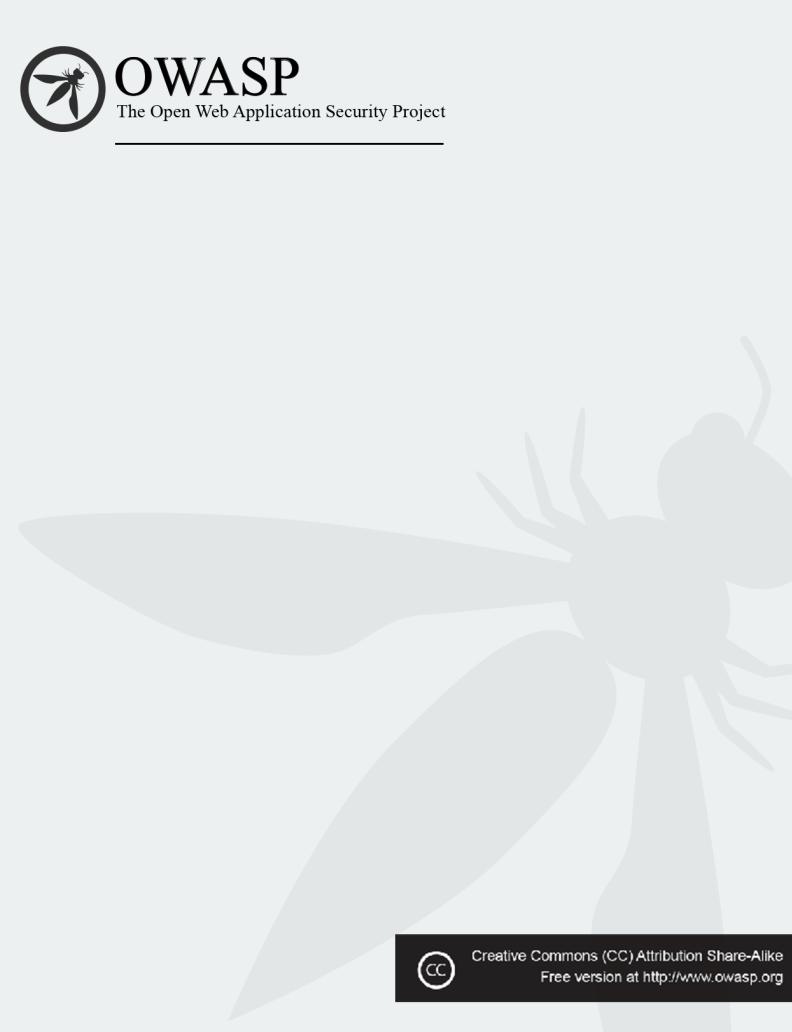
OWASP Application Security
Verification Standard 2013
Web Application Standard

ASVS 2013 |
Web Application Standard |
Preface
Our biggest goal with this version of the standard was to increase adoption.
One of the major challenges of a standard such as this is that it needs to satisfy two distinct, and very different, targets: individuals who are involved in organizing or executing a software security program within their organization, and software security professionals who conduct verification of applications. While both targets seek an industry-accepted standard for verification of applications, they operate under different constraints. For example, one of the most widely voiced criticisms of ASVS 2009 standard was that it specified automated assessments as one of the levels (or sub-levels). Many large organizations see automated assessments as a point of entry into the verification hierarchy, and thus a fully automated level is a convenient concept for them. Information security professionals, however, know that the depth and breadth of such a review will depend on what technology is used to perform the scan, thus leaving too much room for interpretation of the standard. ASVS 2013 introduces a Cursory Level 0 to allow for the flexibility needed to overcome this challenge.
On a similar note, one of the main goals for this version of the standard was to focus on the "what" and not the "how". Whereas the previous version of the standard talked about dynamic scanning, static analysis, Threat Modeling, and design reviews, you will notice that such terms do not appear in this version of the standard. Instead, we essentially define security requirements that must be verified for an application to achieve a certain level. How those requirements are verified is left up to the verifier.
Another major challenge that we overcame is to clearly separate requirements from design from scope. The previous version of the standard did not clearly distinguish between these concepts, leaving room for confusion. In this version, Level 3 is where design considerations are introduced and clearly separated from detailed verification requirements. Furthermore, we have now separated out the concept of scope completely – the new (+) notation allows for a verifier to optionally include third party components and frameworks in their review.
We expect that there will most likely never be 100% agreement on this standard. Risk analysis is always subjective to some extent, which creates a challenge when attempting to generalize in a one size fits all standard. However, we hope that the latest updates made in this version are a step in the right direction, and respectfully enhance the concepts introduced in this important industry standard.
i
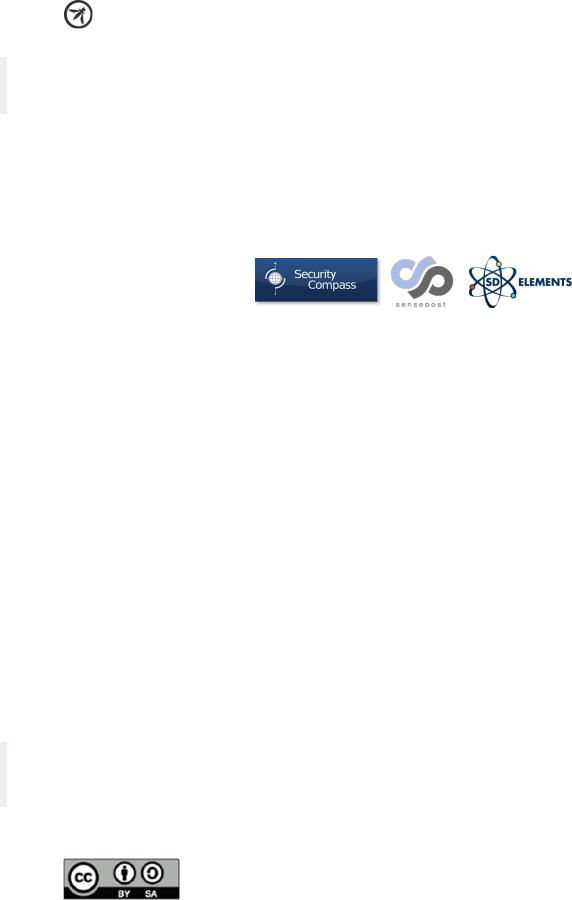
ASVS 2013 |
Web Application Standard |
Acknowledgements
Version 2013 |
|
Project Leads: |
Sahba Kazerooni, Daniel Cuthbert |
Lead Authors: |
Andrew van der Stock, Sahba Kazerooni, Daniel Cuthbert, Krishna Raja |
Reviewers and contributors: |
Evan Gaustad, Archangel Cuison, Etienne Stalmans |
Project Sponsors: |
|
Additionally, thanks are given to the application security verification community and others interested in trusted web computing for their enthusiastic advice and assistance throughout this effort.
Version 2009
As ASVS 2013 includes many of the original requirements, the following contributors are recognized for their efforts during the original Application Security Verification Standard effort.
Project Lead: |
Mike Boberski |
Lead Authors: |
Mike Boberski, Jeff Williams, Dave Wichers |
We thank the OWASP Foundation for sponsoring the OWASP Application Security Verification Standard Project during the OWASP Summer of Code 2008.
Acknowledgement is given for the contributions of: Pierre Parrend (OWASP Summer of Code), Andrew van der Stock, Nam Nguyen, John Martin, Gaurang Shah, Theodore Winograd, Stan Wisseman, Barry Boyd, Steve Coyle, Paul Douthit, Ken Huang, Dave Hausladen, Mandeep Khera Scott Matsumoto, John Steven, Stephen de Vries, Dan Cornell, Shouvik Bardhan, Dr. Sarbari Gupta, Eoin Keary, Richard Campbell, Matt Presson, Jeff LoSapio, Liz Fong, George Lawless, Dave van Stein, Terrie Diaz, Ketan Dilipkumar Vyas, Bedirhan Urgun, Dr. Thomas Braun, Colin Watson, Jeremiah Grossman.
Copyright and License
Copyright © 2008 – 2013 The OWASP Foundation.
This document is released under the Creative Commons Attribution ShareAlike 3.0 license. For any reuse or distribution, you must make clear to others the license terms of this work.
ii

ASVS 2013 |
Web Application Standard |
Table of Contents
Introduction .............................................................................................................................................................................................. |
1 |
How to Use This Standard .................................................................................................................................................................... |
2 |
Application Security Verification Levels.......................................................................................................................................... |
4 |
Level 0: Cursory ................................................................................................................................................................................... |
5 |
Level 1: Opportunistic....................................................................................................................................................................... |
6 |
Level 2: Standard ................................................................................................................................................................................ |
7 |
Level 3: Advanced .............................................................................................................................................................................. |
8 |
Scope of Verification ...................................................................................................................................................................... |
10 |
Detailed Verification Requirements............................................................................................................................................... |
11 |
V1: Authentication Verification Requirements ..................................................................................................................... |
12 |
V2: Session Management Verification Requirements ........................................................................................................ |
15 |
V3: Access Control Verification Requirements...................................................................................................................... |
17 |
V4: Input Validation Verification Requirements ................................................................................................................... |
19 |
V5: Cryptography at Rest Verification Requirements ......................................................................................................... |
21 |
V6: Error Handling and Logging Verification Requirements ........................................................................................... |
22 |
V7: Data Protection Verification Requirements .................................................................................................................... |
24 |
V8: Communications Security Verification Requirements................................................................................................ |
25 |
V9: HTTP Security Verification Requirements........................................................................................................................ |
26 |
V10: Malicious Controls Verification Requirements ............................................................................................................ |
27 |
V11: Business Logic Verification Requirements.................................................................................................................... |
28 |
V12: Files and Resources Verification Requirements .......................................................................................................... |
30 |
V13: Mobile Verification Requirements ................................................................................................................................... |
31 |
Appendix A: Applying ASVS in Practice ....................................................................................................................................... |
34 |
Appendix B: Glossary .......................................................................................................................................................................... |
37 |
Appendix C: Where To Go From Here ........................................................................................................................................... |
40 |
iii

ASVS 2013 |
Web Application Standard |
Introduction
The primary aim of the OWASP Application Security Verification Standard (ASVS) is to normalize the range in the coverage and level of rigor available in the market when it comes to performing web application security verification.
The Open Web Application Security Project (OWASP) is an open community dedicated to enabling organizations to develop, purchase, and maintain applications that can be trusted. All of the OWASP tools, documents, forums, and chapters are free and open to anyone interested in improving application security. We advocate approaching application security as a people, process, and technology problem, because the most effective approaches to application security include improvements in all of these areas. We can be found at www.owasp.org.
OWASP is a new kind of organization. Our freedom from commercial pressures allows us to provide unbiased, practical, cost-effective information about application security. OWASP is not affiliated with any technology company, although we support the informed use of commercial security technology. Similar to many open-source software projects, OWASP produces many types of materials in a collaborative, open way. The OWASP Foundation is a not-for-profit entity that ensures the project’s long-term success.
The ASVS standard provides a basis for testing application technical security controls, as well as any technical security controls in the environment, that are relied on to protect against vulnerabilities such as Cross-Site Scripting (XSS) and SQL injection.1 This standard can be used to establish a level of confidence in the security of Web applications.
1 For more information about common Web application vulnerabilities, see the OWASP Top Ten (OWASP, 2007).
1
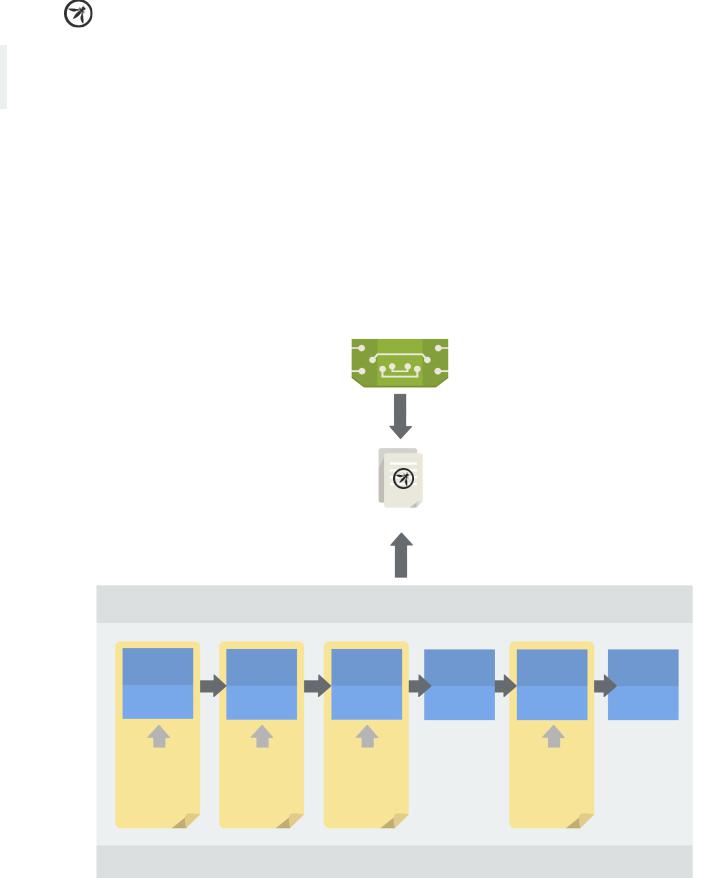
ASVS 2013 |
Web Application Standard |
How to Use This Standard
The ASVS standard can be used by both
consumers and service or tool providers.
ASVS has two main goals, as depicted in the figure below: to help organization’s develop and maintain secure applications; and to allow security service/tools providers and consumers to align their requirements and offerings.
TOOL/SERVICE PROVIDER
ALIGN VERIFICATION
METHODOLOGIES WITH ASVS
STANDARD
ORGANIZATION
OWASP ASVS
ARTICULATE REQUIREMNTS
USING ASVS STANDARD
PROCUREMENT
INTAKE / PLANNING |
REQUIREMENTS |
DESIGN FOR A |
IMPLEMENTATION |
DEPLOY |
PERFORM |
||||
|
DEFINITION BY RISK |
PARTICULAR RISK |
VERIFICATION |
|
|
LEVEL |
LEVEL |
|
|
IDENTIFY YOUR |
DEFINE SECURITY |
CONSIDER ASVS |
VERIFY AGAINST |
APPLICATION’S |
REQUIREMENTS |
DESIGN-LEVEL |
YOUR SELECTED |
RISK ELVEL AND |
BASED ON ASVS |
REQUIREMENTS (IF |
ASVS LEVEL |
MAP TO ASVS |
REQUIREMENTS |
L3) |
|
LEVEL |
FOR YOUR LEVEL |
|
|
DEVELOPMENT
Figure 1 – Uses of ASVS for organizations and tool/service providers
2

ASVS 2013 |
Web Application Standard |
The example scenarios below further demonstrate the common use cases of ASVS using a fictional organization (ACME Bank) and a fictional security services firm (Hack All the Things).
Use Case 1: Certification of Applications
ACME Bank has developed a new Internet Banking portal, which is due to be deployed into their UAT environment. The application has followed the bank’s SDLC process and should be in a secure state. The Internal security team at ACME Bank has been tasked to ensure that once deployed into the UAT environment, it does not pose a risk to other applications, due to it being hosted on a shared platform and database. After an internal threat modeling exercise was performed, it was agreed that the application had a high-risk associated with it and the data stored within it.
The team makes use of a well-known web application scanning tool and start the process of mapping out the application in preparation for the automated scanning phase. Once complete, the automated scanning tool is started and left to complete. Once the report has been generated, the security analyst tests for false positives (such as SQL injection, or XSS) and amends the report as necessary. Any findings discovered are reported back to the system owners and development team, in order to be rectified. Once this has been completed, the re-test of the application is resumed to ensure they have been resolved in a suitable manner.
In this example, using the ASVS could allow the internal team to test for common application flaws as well as verify that it had been developed in accordance to the banks security standard.
Use Case 2: Alignment of testing methodology
Hack All the Things (HATT) is a penetration-testing consultancy, whose main area of expertise is performing application security assessments for clients at an infrastructure and application level. They have decided to align their internal testing methodology with that of the OWASP ASVS to offer their clients peace of mind when performing assessments.
In order to achieve this, all staff are required to manually test the application in question using the detailed verification requirements, as outlined by the ASVS document.
In this instance, adopting the ASVS allows HATT to offer a series of application assessments based on the four ASVS levels, and at the same time, allowing clients to understand what has been assessed.
Use Case 3: Selection of external supplier
ACME Bank has finally completed all development on their new Internet Banking portal and the banking regulators require them to have an external consultancy perform an assessment of the application, to ensure it meets the regulatory requirements with regards to security.
ACME Bank has chosen a supplier from their list of preferred suppliers and asks HATT to perform an assessment. ACME Bank supplies the consultancy with all the source code and documentation and schedules the assessment. The external test is conducted in a phased approach, with a full-automated static analysis code review performed on the source code alongside a manual application security assessment. In addition, business logic is tested to ensure that the application performs as expected, as outlined in the functional specification documentation supplied. Once the assessment is complete, a report is created and delivered to ACME Bank staff.
By both parties adopting the ASVS during this process, the suitable level is chosen and tested for. As a result, both ACME bank and HATT are in sync with what has to be achieved and what the required outcome is.
3
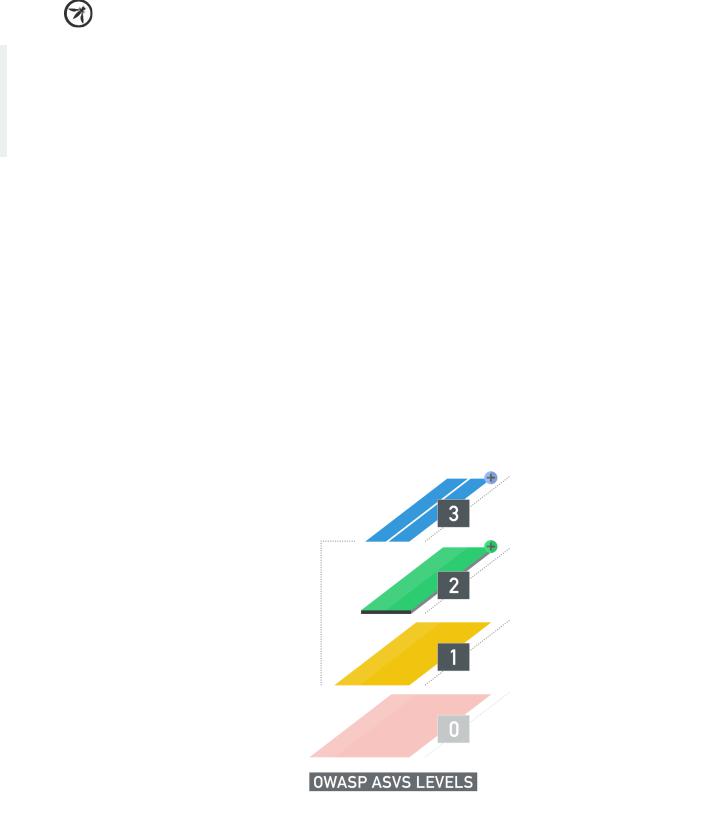
ASVS 2013 |
Web Application Standard |
Application Security
Verification Levels
The ASVS defines four levels of verification, with
each level increasing in breadth as the
application moves up the levels.
The breadth is defined in each level by a set of security verification requirements that must be addressed. It is a verifier’s responsibility to determine if a target of verification (TOV) meets all of the requirements at the level targeted by a review. If the application meets all of the requirements for that level, then it can be considered an OWASP ASVS Level N application, where N is the verification level that application complied with. If the application does not meet all the requirements for a particular level, but does meet all the requirements for a lower level of this standard, then it can be considered to have passed the lower level of verification.
ADVANCED
ASVS DEFINES DETAILED
VERIFICAITON REQUIREMENTS FOR
LEVELS 1 AND ABOVE; WHEREAS
STANDARD
LEVEL 0 IS MEANT TO BE FLEXIBLE
AND IS CUSTOMIZED BY EACH
ORGANIZATION.
OPPORTUNISTIC
CURSORY
Figure 2 – OWASP ASVS Levels
The depth of the verification is defined by the scope of the application included when verifying each security requirement. For example, the scope of the verification may go beyond the application’s custom-built code and include external components. Achieving a verification level under such scrutiny can be represented by annotating a “+” symbol to the verification level.
4
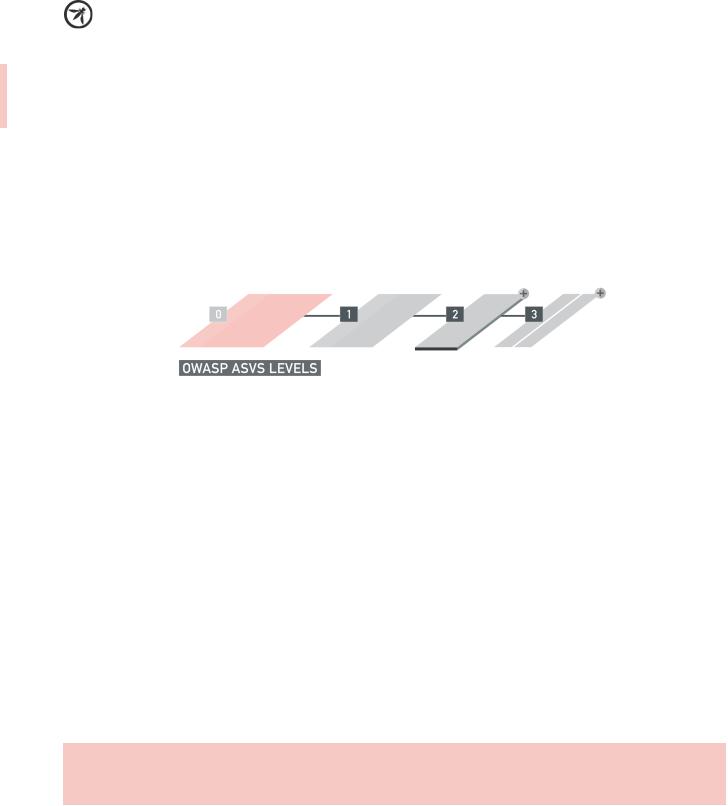
ASVS 2013 |
Web Application Standard |
Level 0: Cursory
Level 0 (or Cursory) is an optional certification, indicating that the application has passed some type of verification.
Figure3 – OWASP ASVS Level 0
Level 0 is designed to be a flexible point of entry into the verification hierarchy; it indicates that some type of review has been done on the application. The detailed verification requirements are not provided by ASVS. Instead, organizations can define their own minimum criteria (such as automated runtime scan, or strong authentication mechanism).
This level is most appropriate for organizations that have a large number of applications, and where a low cost point of entry may be required. One organization may use Level 0 to require a cursory automated scan of all of their external facing applications using the organization’s commercial tool of choice; whereas another organization may define L0 requirements using data from a recent breach.
Unlike the other ASVS levels, Level 0 is not a prerequisite for other levels - an application can jump straight to Level 1 without achieving Level 0 certification (if L0 is not defined by the organization).
When defining Level 0 requirements, it is advised that each requirement be documented in a similar manner to the Detailed Verification Requirements in this document – clear, distinct, realistic, and verifiable.
Overview of Verification Requirements
L0 ASVS does not define the detailed verification requirements for this level. Application is assessed according to cursory requirements as defined by the organization.
5
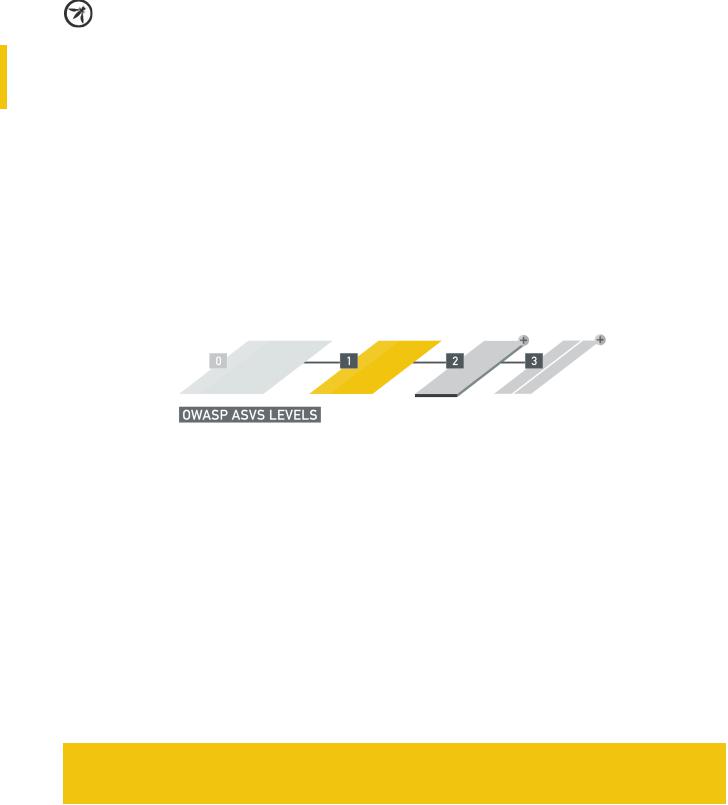
ASVS 2013 |
Web Application Standard |
Level 1: Opportunistic
An application achieves Level 1 (or Opportunistic) certification if it adequately defends against application security vulnerabilities that are easy to discover.
Figure 4 – OWASP ASVS Level 1
The specific set of vulnerabilities against which Level 1 verification is measured is detailed in the Detailed Verification Requirements, but typically includes vulnerabilities that a verifier can identify with minimal-to- low effort. As such, this level cannot be considered a thorough inspection or verification of the application, but more of a quick inspection.
Level 1 is typically appropriate for applications where some confidence in the correct use of security controls is required, or to provide a quick sweep of a fleet of enterprise applications, to assist in developing a roadmap for more thorough inspections at a later date.
Threats to the application will most likely be from attackers who are using simple techniques to identify easy- to-find and easy-to-exploit vulnerabilities. This is in contrast to a determined attacker who will spend focused energy to specifically target the application.
Overview of Verification Requirements
L1 Application is assessed according to the Level 1 requirements in the “Detailed Verification Requirements” section.
6
